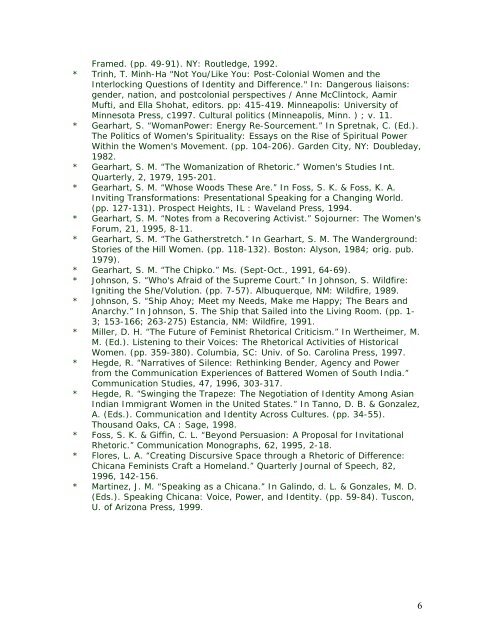COMS742: Feminist Rhetorical Theory - Ohio University
COMS742: Feminist Rhetorical Theory - Ohio University
COMS742: Feminist Rhetorical Theory - Ohio University
Create successful ePaper yourself
Turn your PDF publications into a flip-book with our unique Google optimized e-Paper software.
Framed. (pp. 49-91). NY: Routledge, 1992.<br />
* Trinh, T. Minh-Ha "Not You/Like You: Post-Colonial Women and the<br />
Interlocking Questions of Identity and Difference." In: Dangerous liaisons:<br />
gender, nation, and postcolonial perspectives / Anne McClintock, Aamir<br />
Mufti, and Ella Shohat, editors. pp: 415-419. Minneapolis: <strong>University</strong> of<br />
Minnesota Press, c1997. Cultural politics (Minneapolis, Minn. ) ; v. 11.<br />
* Gearhart, S. “WomanPower: Energy Re-Sourcement.” In Spretnak, C. (Ed.).<br />
The Politics of Women's Spirituality: Essays on the Rise of Spiritual Power<br />
Within the Women's Movement. (pp. 104-206). Garden City, NY: Doubleday,<br />
1982.<br />
* Gearhart, S. M. “The Womanization of Rhetoric.” Women's Studies Int.<br />
Quarterly, 2, 1979, 195-201.<br />
* Gearhart, S. M. “Whose Woods These Are.” In Foss, S. K. & Foss, K. A.<br />
Inviting Transformations: Presentational Speaking for a Changing World.<br />
(pp. 127-131). Prospect Heights, IL : Waveland Press, 1994.<br />
* Gearhart, S. M. “Notes from a Recovering Activist.” Sojourner: The Women's<br />
Forum, 21, 1995, 8-11.<br />
* Gearhart, S. M. “The Gatherstretch.” In Gearhart, S. M. The Wanderground:<br />
Stories of the Hill Women. (pp. 118-132). Boston: Alyson, 1984; orig. pub.<br />
1979).<br />
* Gearhart, S. M. “The Chipko.” Ms. (Sept-Oct., 1991, 64-69).<br />
* Johnson, S. “Who's Afraid of the Supreme Court.” In Johnson, S. Wildfire:<br />
Igniting the She/Volution. (pp. 7-57). Albuquerque, NM: Wildfire, 1989.<br />
* Johnson, S. “Ship Ahoy; Meet my Needs, Make me Happy; The Bears and<br />
Anarchy.” In Johnson, S. The Ship that Sailed into the Living Room. (pp. 1-<br />
3; 153-166; 263-275) Estancia, NM: Wildfire, 1991.<br />
* Miller, D. H. “The Future of <strong>Feminist</strong> <strong>Rhetorical</strong> Criticism.” In Wertheimer, M.<br />
M. (Ed.). Listening to their Voices: The <strong>Rhetorical</strong> Activities of Historical<br />
Women. (pp. 359-380). Columbia, SC: Univ. of So. Carolina Press, 1997.<br />
* Hegde, R. “Narratives of Silence: Rethinking Bender, Agency and Power<br />
from the Communication Experiences of Battered Women of South India.”<br />
Communication Studies, 47, 1996, 303-317.<br />
* Hegde, R. “Swinging the Trapeze: The Negotiation of Identity Among Asian<br />
Indian Immigrant Women in the United States.” In Tanno, D. B. & Gonzalez,<br />
A. (Eds.). Communication and Identity Across Cultures. (pp. 34-55).<br />
Thousand Oaks, CA : Sage, 1998.<br />
* Foss, S. K. & Giffin, C. L. “Beyond Persuasion: A Proposal for Invitational<br />
Rhetoric.” Communication Monographs, 62, 1995, 2-18.<br />
* Flores, L. A. “Creating Discursive Space through a Rhetoric of Difference:<br />
Chicana <strong>Feminist</strong>s Craft a Homeland.” Quarterly Journal of Speech, 82,<br />
1996, 142-156.<br />
* Martinez, J. M. “Speaking as a Chicana.” In Galindo, d. L. & Gonzales, M. D.<br />
(Eds.). Speaking Chicana: Voice, Power, and Identity. (pp. 59-84). Tuscon,<br />
U. of Arizona Press, 1999.<br />
6
















